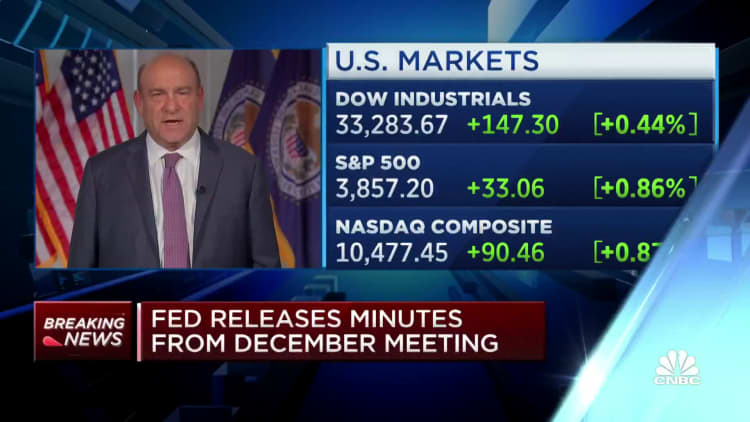
Federal Reserve officials are committed to fighting inflation and expect higher interest rates to remain in place until more progress is made.
They expressed the importance of keeping restrictive policy in place when they raised their key interest rate by half a percentage point.
The meeting summary states that participants observed that a restrictive policy stance would need to be maintained until the incoming data provided confidence that inflation was on a sustained downward path to 2 percent. Several participants commented that historical experience cautioned against premature easing of monetary policy.
The increase ended a streak of four consecutive three-quarter point rate hikes and took the target range for the fed funds rate to 4%-4.5%, its highest level in 15 years.
As they move forward, officials said they would look at the need to retain flexibility and optionality.
The public shouldn't read too much into the Federal Open Market Committee's decision to step down the pace of increases
The minutes said that a number of participants emphasized that it would be important to clearly communicate that a slowing in the pace of rate increases was not an indication of any weakness in the Committee's resolve to achieve its price stability goal or a judgement that inflation was already on a downward path.
While there has been some progress in the battle against inflation, Fed Chairman Powell believes that rates will not go down even after the increases stop.
The minutes showed that the members of the Federal Open Market Committee don't expect to cut rates in the foreseeable future.
After pausing to evaluate the impact of the hikes on the economy, markets are currently pricing in a rate increase of up to 0.75 percentage point. The central bank is expected to approve a quarter point increase at the next meeting.
The current pricing shows a chance of a small reduction in rates by the end of the year. Fed officials have expressed doubts about loosened policy in the future.
According to the minutes, officials are wrestling with two policy risks, one that the Fed doesn't keep rates high enough, and the other that the Fed keeps restrictive policy in place too long.
Members think the risks are more weighted to easing too soon and allowing inflation to run rampant.
The minutes stated that upside risks to the inflation outlook remained a key factor shaping the outlook for policy. Maintaining a restrictive policy stance until inflation is clearly on a path toward 2 percent is appropriate from a risk-management perspective, according to participants.
The Fed has been reducing the size of its balance sheet by allowing the proceeds from maturing securities to roll off each month instead of being reinvested. The Fed's balance sheet contract has increased by $364 billion since the program began.
The labor market, a key target of the rate increases, has not been affected by the recent inflation metrics. The number of job openings is still twice the pool of available workers despite the fact that nonfarm payroll growth has exceeded expectations.
The personal consumption expenditures price index less food and energy was at 4.7% annually in November, down from its 5.4% peak in February 2022, but still above the Fed's 2% target.
Economists expect the U.S. to enter a recession in the coming months due to the Fed's tightening and the economy running near 40-year highs. The Atlanta Fed says that fourth-quarter GDP is tracking at a 3.9% rate, the best of a year that started out with negative readings.
The president of the Minneapolis Fed said in a post that the funds rate could rise to 5.4% if inflation doesn't trend down.